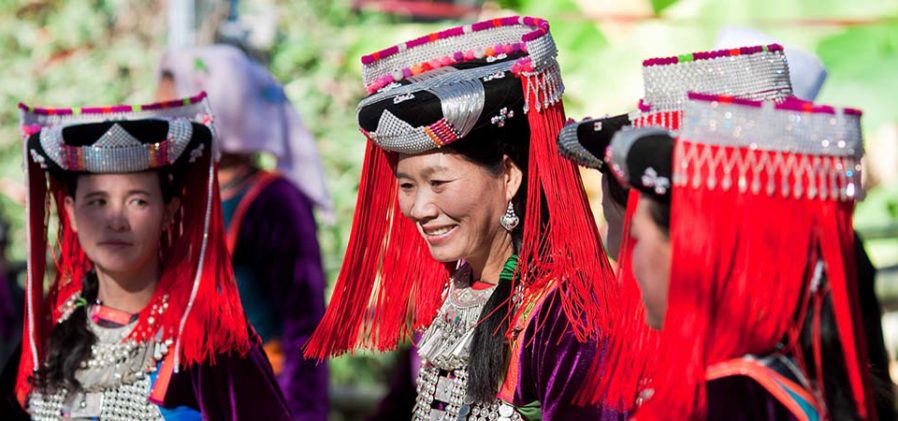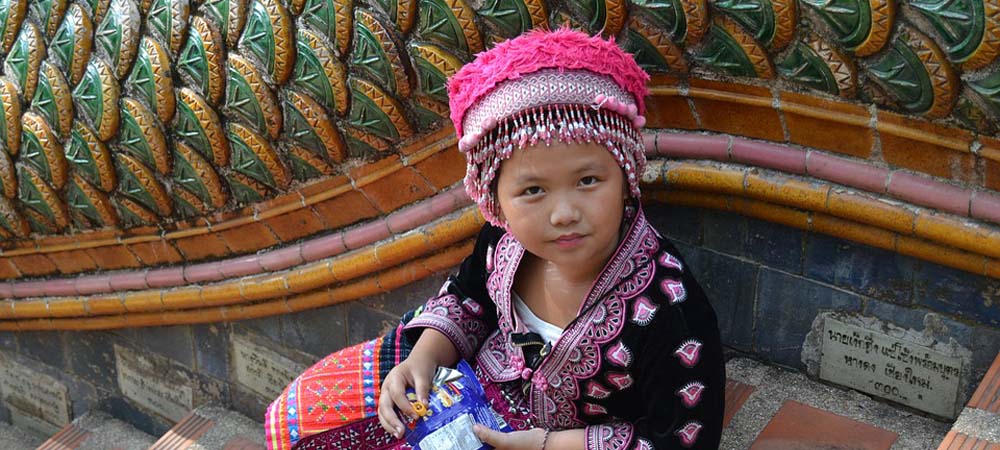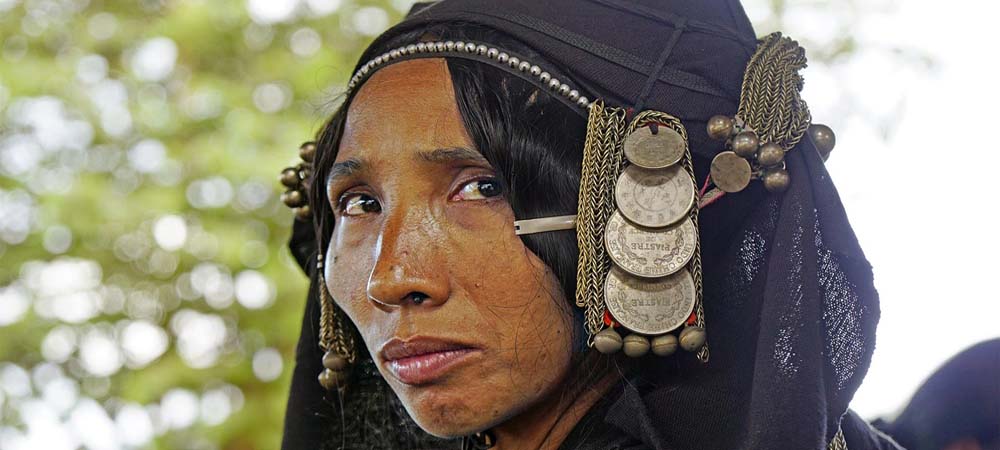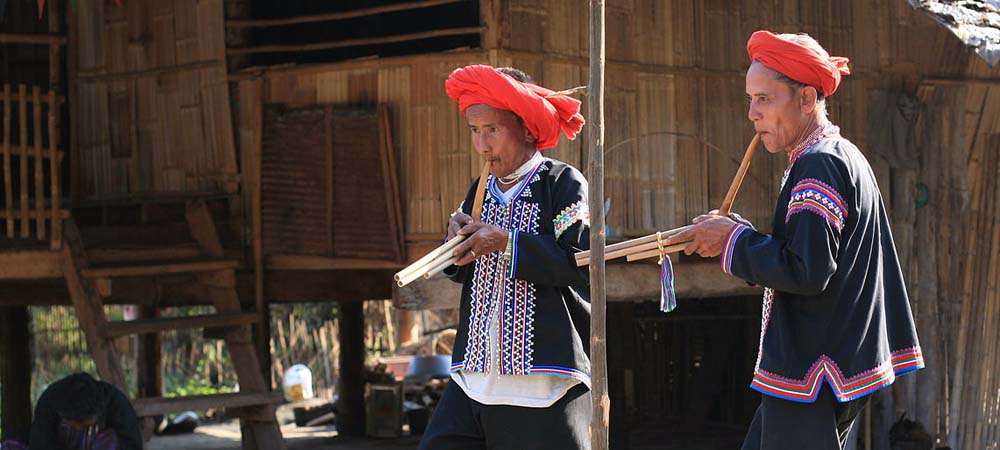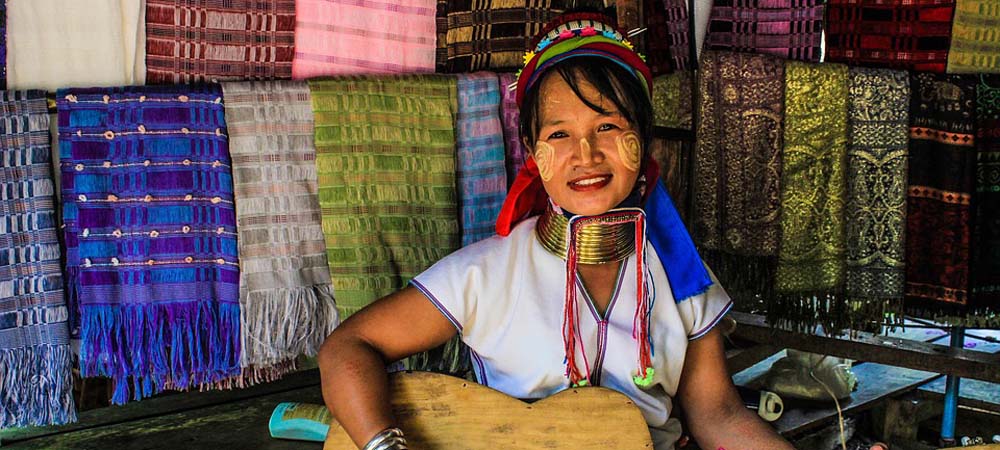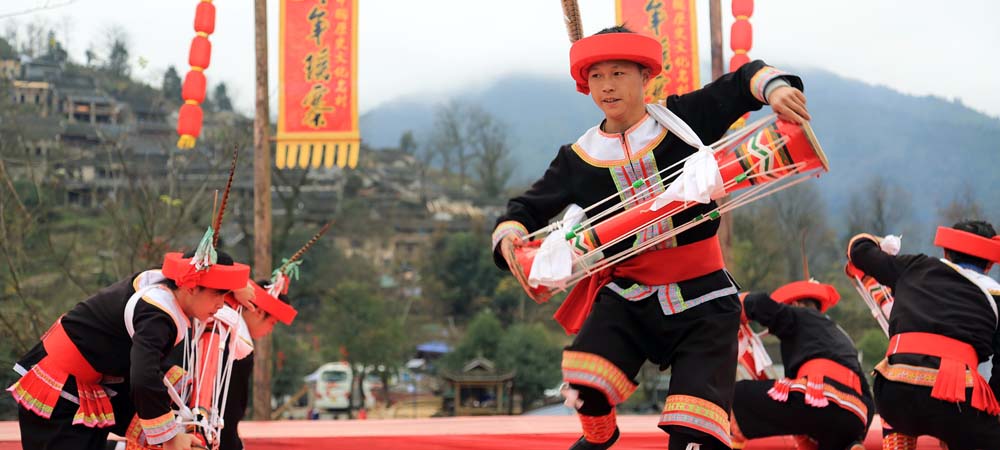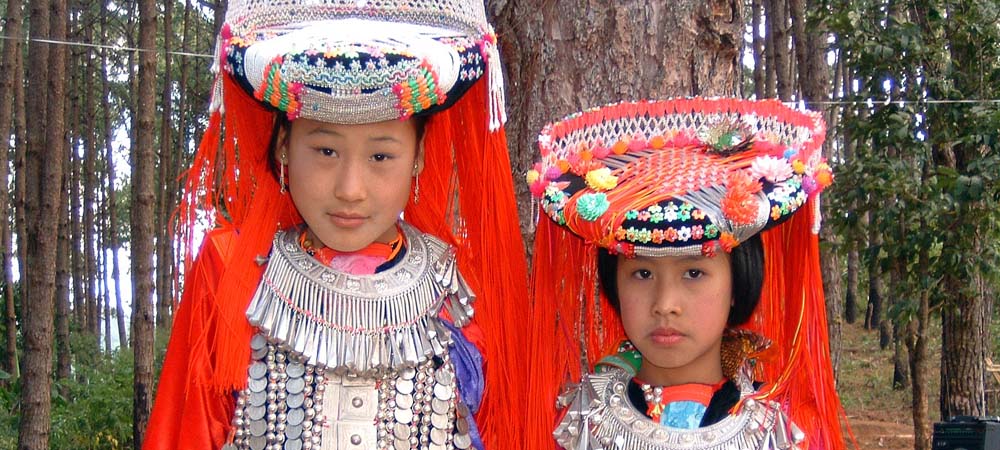It’s no secret that in the furthest corners of the world where waters run wild and forests are left to grow freely that groups of people live alongside nature in perfect amicable harmony. Tribal peoples across the world have always been a keen point of interest for those outside the tribes, conjuring up curiosity of how they live, worship, speak, dress and what they eat to name but a few common queries. If you’ve ever wondered yourself about the tribes of South East Asia, look no further. These are the most well-known tribes in the region, with a little bit about each so you can get to know them a bit better.
Hmong
The Hmong people of Asia are a subgroup of the Miao tribe of China. Hmong tribes are found extensively throughout the region, mainly in China, Laos, Vietnam and Thailand, a migration which happened in the 16th century following oppression by the Han people of China. The Hmong have numerous subgroups that exist under the main umbrella term of ‘Hmong’, many of which are distinguished by the colour in their name, such as Green Hmong or White Hmong. These variations all speak their own dialects of the language with regional variations and will also sometimes wear clothing with the colour of their Hmong subgrouping on it, such as white pleated skirts for the White Hmong.
Hmong Girl
Many Hmong were recruited by the CIA during the Laotian Civil War, and as a result were exiled from the region after the war ended with many going to North America and Australia as refugees to escape possible retaliation from the regional governments. Many also fled to Thailand where they were accepted as refugees. A Thai-Lao cooperative was eventually set up to help repatriate many Lao Hmong, with mixed feelings and results.
Known for their beautiful handicrafts, particularly their weaving and basket-making, the Hmong-made items make for ideal souvenirs of your trip to Asia. Many Hmong wear brightly coloured clothing with intricate embroidery on sleeves, hems and necklines, making Hmong items such as wallets, purses and more popular items amongst tourists. Often found on markets in the likes of Vientiane and Luang Prabang, your only question will be ‘what to buy?’.
Hmong foods are primarily made up of what is available to them. Being keen agriculturalists means that vegetables are widely used in rice and soup dishes, both of which are considered Hmong staples. They also eat papaya salad, a traditional regional spicy salad as well as Hmong barbecued sausage. Be sure to try out their purple sticky rice – a celebratory dish that is served during festivals, New Year and more.
Akha
These hill people formerly graced the hills of southern China’s Yunnan province as late as the early 20th century at which point they migrated into the higher elevations of Myanmar, Laos and Thailand. Issues with civil wars in Laos and Myanmar meant that many of the Akha feld and resettled in Thailand, primarily in Chiang Mai and Chiang Rai where they can be visited on day tours today.
Akha Hilltribe Woman
The Akha language, also known as Akha, is considered to be a Loloish variation of the Sino Tibetan regional languages. The Chinese government classifies the Akha hill tribes as a part of the Hani people, but the Akha view themselves as an entirely different subgrouping. The Akha themselves believe that their ancestral origins were the Tibetan borderlands, but some scholars believe that it’s more likely they’ve originated from some parts of Yunnan province, much like the Hmong. Like the Hmong, the Akha also migrated south, mainly into Burma, but decades of fighting and civil unrest saw the Akha also fleeing into neighbouring Thailand in the 20th century for refuge.
The Akha today unfortunately face issues surrounding respect by people in the countries they inhabit and rarely are seen as equals. This is the opposite to Akha tribal life, which is considered to be extremely egalitarian where respect is indeed earned and given of the basis of age and experience. Some Akha have built permanent homes in the higher altitudes of Laos and Thailand where they farm a number of crops including coffee. Other Akha remain nomadic and move around, taking materials to rebuild temporary homes with them as they go.
The Akha are skilled farmers and raise livestock for their food as well as to help with farm work. Pigs are a particularly popular source of meat, with many of the soups and dishes consumed by the Akha featuring various cuts of pork.
The Akha revere their genealogy and are expected to be able to recite their patriarchal lineage back fifty generations. There are significant rules that govern life, death, marriage and birth, including the belief that deaths caused by injury (such as by a tiger) must have the body burned in specific ways. Likewise, the birth of twins is said to be ominous and until only recently the babies would have been killed to avoid bringing bad luck to the village. The most important festival for the Akha is the annual ‘Swing Festival’ which takes place each August in which offerings will be left to ancestral spirits on a special ancestral altar, usually consisting of bits of meat, rice, whiskey and more. The festival is also the time when then women will showcase the new clothes they have spent the year making, a process which denotes which women are reaching a marriageable age as the clothing will highlight her readiness to wed.
Lahu
The Lahu, like the Hmong and Akha, are a hill tribe that originated in China and still primarily live there to this day. While some have made the move further south into Laos, Thailand and Myanmar, many more have stayed behind in Yunnan, mainly in Lancang Lahy Autonomous County. Also like the Hmong, some Lahu were recruited by the CIA in help fighting the Pathet Lao during the Laotian Civil War.
Lahu Flute Players (Common Wikipedia)
The Lahu can be divided into several distinct subgroups, also, like the Hmong, identified with colours which are often distinctive on their clothing. Like the Akha, the Lahu language is part of the Loloist subgrouping of Tibetan-Burmese languages. Unlike the Akha, the Lahu were traditionally polytheist in religion with Buddhism becoming widespread beginning in the 17th century. Today many Lahu in China remain Buddhist, but since the introduction of Christianity in the 19th century, many more Lahu are making the conversion. Due in part to Bible translations and readings, the Lahu in some regions have begun to include words from Greek, Latin and English to their own regional dialects. Rice is a staple of the Lahu, like many hill tribes, and dry rice is common. As with the Hmong and Akha, noodle and rice soups as well as pork dishes are generally the go to meals for this group.
Kayan (Karen)
Possibly one of the most recognisable tribes in all of Asia, the Kayan people are a subgrouping of the Red Karen, an ethnic group which migrated during the Bronze age from Mongolia to their present day locations in Kayah and Shan states in Myanmar. This hill tribe is famous for the women wearing the brass coils around their necks to elongate and lengthen their necks, a practice that begins when a Kayan woman is around five years old, with subsequent and longer coils added as they age. The coils actually push the shoulders down, instead of lengthening the neck as is assumed. The result is only the illusion of an elongated neck, when in reality it’s the torso that is mainly affected. The coils may have a number of uses, from protecting from tiger bites to making them less attractive for slavery purposes by other tribes. It’s also believed to be playing on the beauty of an elongated neck, thus making women wearing the coils more beautiful. After the coils are put on, they are rarely removed as the process is a long one. It’s also believed that the elongated neck resembles that of a dragon, an important aspect of Kayan mythology.
Karen Long Neck Hilltribe Woman
Like the Akha, Hmong and Lahu, their language is in the family of Tibetan-Burmese languages. Making primarily Myanmar their home, they fled to the Thai border regions in the 80s and 90s during the problems with the Myanmar military regime and the conflict. The result was the development of a touristic region where the Kayan can be visited to see their daily way of life. This resulted in the villages becoming entirely self sufficient, living off tourism revenue and therefore they needed no funding or assistance from the government. Today, a Karenni People’s Liberation association is working to try to invite these Kayan back to Kayah State in Myanmar to set up their own tourist villages in an effort to draw tourism to that particular area.
Interestingly, the majority of Kayan are Roman Catholic due to the intervention by Italian missionaries which worked on them from the 19th century to convert. Many others are Buddhist while others have retained their traditional religion, Kan Khwan, where the Kayan believe they were created between the union of a female dragon and an angel/human hybrid. Consider adding a day trip out to see the Kayan to any of Explorient’s tours to the area, such as the Myanmar and Thailand Spectacular.
Yao
The Yao people of southern China are descended from the main line of Mien people. With a population of around nine million spread through Yunnan, Thailand, Laos and Vietnam, they are one of the larger of the hill tribes found throughout the area. Originally coming from Hunan, the Yao and Hmong were both in the rebel group against the Miao Rebellions during the Ming Dynasty. When the Han people began to expand into their lands, the Yao fled further and further to the south and east into Guizhu and Guangdong, until eventually they reached Yunnan.
Yao Dancers
Like the Hmong and the Lahu the Yao were an effective force for the CIA during the Laotian Civil War and they fought in favour of the government against the communists, a move that would make them a target by the new communist government after the end of the war, causing them to move closer and closer to Thai border areas.
For over a thousand years the Yao have been skilled farmers. Many use plows to help develop rice plantations, a staple for the Yao. They also hunt different types of game including deer on top of farming for sustenance. Their clothes tend to have some level of blue to them, which is made with indigo, making the Yao stand out in terms of clothing. Their religion has historically been predominantly Daoist because of the Han influence but over time they have been found to incorporate aspects of Daoism, pre-Daoist folk beliefs and Buddhism.
See about adding a day trip out to visit the Yao hill tribe to Explorient tours such as the China and Thailand private luxury tour.
Lisu
The Lisu people are a hill tribe that today live in parts of Yunnan and Sichuan provinces in China as well as Myanmar, Thailand and Arunachal Pradesh in the very northeastern India. They are believed to have originated in Tibet thousands of years ago, even before more modern day Tibetans arrived in the area. Along with the Lahu and Akha, the Lisu speak a dialect of the Tibetan-Burmese language family. They are also one of the Lolo tribes, relating them distantly to other Loloish tribes such as the Akha and Lahu.
Girls from Lisu Hilltribe
The Lisu moved over time from the Tibetan plateau through Yunnan and eventually into their present day areas. The Lisu of India have progressively had issues with the Indian government over the years due to their immigration status – mainly listed as refugees from Myanmar. Lisu villages tend to be built close to water to allow for easy drinking, washing and fishing while their homes are made of mainly bamboo with dirt flooring. More modern Lisu however are opting to build more stable housing from concrete and stone.
The Lisu, like the Akha were traditionally animist and had a deep and profound shamanistic spirituality with a heavy focus on ancestral worship and honour. Sacrifices would be offered to appease mountain and forest spirits and each family kept ancestral shrines in their home. Many villages would keep a sacred grove where offerings to the Creator would be made as well. Over time, following visits from a number of Christian missionaries, the Lisu converted to primarily Christianity; much like the Kayan converted to Catholicism.
There are a number of hill tribes throughout the region that tourists are able to visit, making for an amazing and unique day out during any trip to South East Asia. Be sure to add a tour to your package to meet these inspiring and welcoming people for yourself to learn more about them and to meet them up close and personal, making your trip even more special than it already is.

